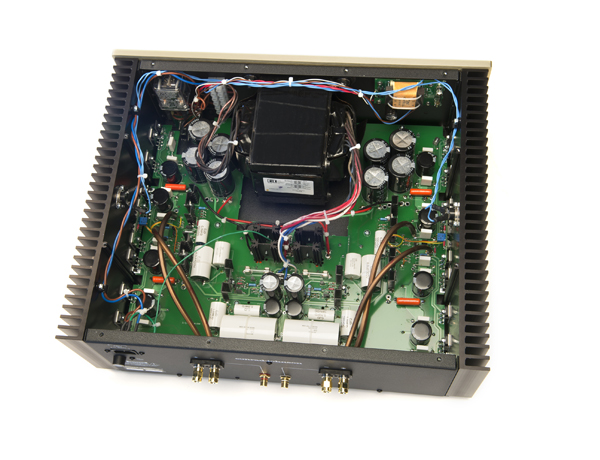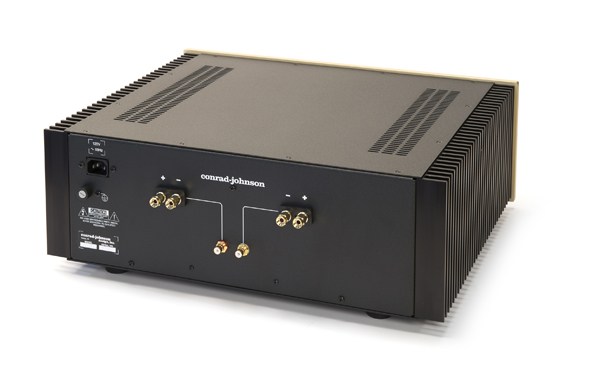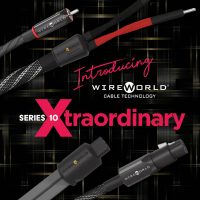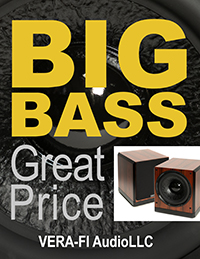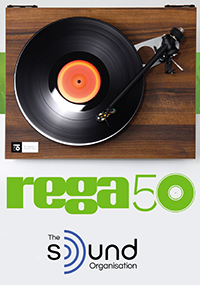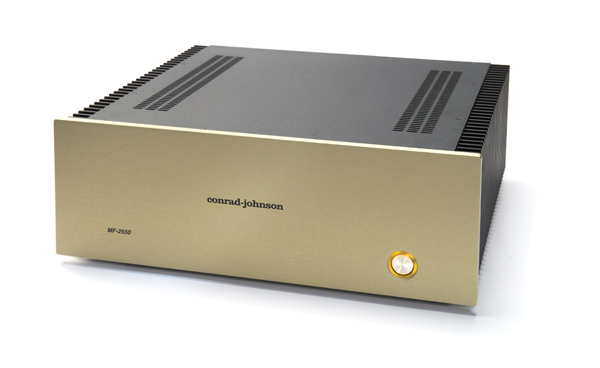 The generally accepted wisdom is that tube amps display a warm sound while solid-state amps offer more punch and control. But those lines are blurring, with great designs in both camps that defy past assumptions—and this is where Conrad-Johnson comes to mind. Compared to the company’s legendary valve-based gear, its MF2550 power amp takes a different approach—namely the fact that it’s solid state. The amp is available as a standard or special-edition (SE) version, the latter of which is priced at $7,800 and includes CJD Teflon hybrid capacitors and precision foil resistors. We did not have the opportunity to test these two versions side by side, but considering the outstanding performance of the SE version, it’s likely that the standard version is no slouch.
The generally accepted wisdom is that tube amps display a warm sound while solid-state amps offer more punch and control. But those lines are blurring, with great designs in both camps that defy past assumptions—and this is where Conrad-Johnson comes to mind. Compared to the company’s legendary valve-based gear, its MF2550 power amp takes a different approach—namely the fact that it’s solid state. The amp is available as a standard or special-edition (SE) version, the latter of which is priced at $7,800 and includes CJD Teflon hybrid capacitors and precision foil resistors. We did not have the opportunity to test these two versions side by side, but considering the outstanding performance of the SE version, it’s likely that the standard version is no slouch.
The MF2550 is rather nondescript and traditional in its appearance. The black metal chassis, which measures 16.25 inches deep, 19 inches wide, and 6.125 inches tall, features a faceplate made of thick aluminum with gold anodizing and a brushed-matte finish. Among my other black and silver audio components, the amp’s gold color—a signature of CJ—certainly stands out. The only feature interrupting the smooth faceplate is a power button the size of a quarter on the lower right corner. A gentle yellow LED halo illuminates the button when pressed. The only thing distinguishing the special-edition amp from the standard version is a small plate on the back of the unit that notes the serial number and the SE designation.
Connecting the amp could not be easier, with a set of RCA inputs and the requisite speaker binding posts; it takes only two minutes and a little finger strength to get the amp up and running. I appreciate the amp’s five-way metal binding posts, which effortlessly handle a post wrench. The posts easily accommodate two-banana adapters and offer plenty of space to connect spades and even bare-ended wire.
Pushing the gold-colored button to reveal the sonic prowess within, I first wonder if the amp is on, since it is silent. Even the ribbon tweeters in my Piega P-10 speakers do no hiss at the visiting power source.
Hidden Treasure
Much of the amp’s 52-pound weight comes from the hefty power supply fueling 250 watts into 8 ohms, or 500 watts into 4 ohms. On paper, the MF2550’s power output is a dead-ringer for my Mark Levinson reference amp, so it’s exciting to swap in the CJ. There are indeed many similarities between the two amps, as well as a few key differences.
Three-dimensional presentation is a dramatic strength of this amp. Music appears independent of the speakers and audible in all directions. Left-to-right imaging extends the music well beyond the speaker boundaries, with a very convincing central image. The amp also pinpoints other musical elements across the soundstage. Front-to-back layering leaves the vocalist up front, while allowing ambient background sounds to extend beyond the rear wall of my listening space. There’s no perceived vertical limitation either, as the music extends from floor to ceiling. On Lyle Lovett’s song “Church,” from his Joshua Judges Ruth album, the background vocalists are rendered well behind Lovett, who appears front and center. While my reference amp is quite good in its ability to layer musical elements, the CJ exceeds it.
The MF2550 takes command of my speakers with deep, rich and robust bass. Compared with my reference amp, the MF2550’s bass response is not quite as tight and punchy. Rage Against the Machine remains one of my guilty pleasures. The band’s song “Bombtrack” provides a good reference point for bass. Through the CJ, the bass portrayal is not loose or lacking depth, though there’s just a touch less immediacy and excitement compared to my Levinson.
Throughout my listening experience, there’s a very slightly warm tendency to this solid-state amp, which I wasn’t expecting. To be clear, the CJ does not overly romanticize the sound; it’s just a bit more forgiving than I’m used to. There’s a slight gentleness when listening to recordings that usually prove overly revealing. I’m able to turn the volume up higher for an immersive music experience without any hard-edged notes piercing my eardrums. At first, I wonder if some higher frequencies are rolled off, but after testing several frequency sweep tracks, all the highs are there. The CJ’s design just manages to somehow take most sting and vocal sibilance out.
Some live instruments can have an inherent bite. During live performances, it’s never pleasant to be in the blast zone of a trumpet, saxophone, snare drum, or cymbal crash. Nevertheless, that experience is the reality of the music. Through the CJ’s portrayal of music in my own system, while subtle, there’s just a touch less detail and realism. For instance, the sonic decay of the cymbal on the Dave Brubeck Quartet’s “Blue Rondo à la Turk” subsides more quickly than I’m used to. At the same time, the Civil Wars’ “Dust to Dust” on vinyl proves an utterly opulent experience. Minute sonic details aside, it’s easy to find oneself immersed in the emotion and beauty of the song.
I would not call this amp euphonic, but it leans to the side of forgiving musicality, as opposed to pure realism. Is this a bad thing? No. On a sunny day, many folks prefer to tame the glare with sunglasses, right? Similarly, if your system is a bit bright for your taste, or if you just prefer a portrayal that’s a tad relaxed, the MF2550 may provide the balance you’ve been looking for.
The Golden Ticket?
I thoroughly enjoyed the month I spent with the MF2550 SE in my system, as did several of my friends who regularly come over to listen. The MF2550 SE is something I could enjoy happily for a long time. On vocally driven performances, jazz and orchestral pieces, the CJ leaves little to desire. For those who prefer rock music with all its inherent aggression and vigor, the CJ stands more toward the polite end of the spectrum. In all cases, though, the musicality of the performance shines though.
With plenty of power and a non-fatiguing presence, this amp will likely pair well with many speakers and components. It certainly plays nicely with all my test equipment. Given its $7,800 retail price, the amp represents a long-term investment for many audio fans, but many rewards come with it.
Combining great sound with substantial build quality and a three-year warranty on parts and labor, the MF2550 SE could be something that you find at the end of your quest for sonic treasure. If these benefits sound compelling to you, definitely make a run to your local Conrad-Johnson dealer and hear for yourself what this amp can do.
Additional Listening
By Jeff Dorgay
While so many audio enthusiasts think of Conrad-Johnson as a strictly vacuum-tube company, the brand has made some very impressive solid-state amplifiers over the years. The benchmark that comes to my mind is its Premier 350, which served as my reference amplifier for years. So when Lew Johnson told me about the MF2550 SE, this was the immediate comparison floating around in my head. But Johnson was quick to point out that the MF2550 SE is a “completely different amplifier” that would really surprise me.
And surprise it does. Thanks to a bevy of CJD Teflon capacitors, the ones that have been highly influential in the sound of CJ for the last 10 years or so, the MF2550 SE has a thoroughly modern sound. Bringing back my Premier 350, along with CJ’s ACT2 Series 2 preamplifier, makes it easy to compare and contrast the two amps.
Overall, the MF2550 SE has a very dynamic, extended sound. Those of you who remember the company’s early solid-state amplifiers and who did not experience the Premier 350 will be stunned at just how spectacular this new amplifier sounds, especially considering how well CJ is known for vacuum-tube amplifiers. The overall tonality is highly natural, with barely a hint of warmness. It’s not quite as neutral as, say, the top-of-the-line Simaudio Moon amplifiers that we’ve listened to or the Premier 350, but it’s not as warm as my Burmester 911 MK3 or the Pass XA series amplifiers.
Running the MF2550 SE through its paces with a wide range of speakers, including the Focal Maestro Utopia, Dynaudio Evidence Platinum, and even my old Acoustat 2+2s, reveals that this amplifier will drive any speakers comfortably, with power to spare. Whether rocking out with AC/DC, or relaxing with a string quartet, this amplifier presents a wide, deep soundstage and a level of nuance and control usually associated with a much more expensive amplifier.
As with the Premier 350, Conrad-Johnson’s MF2550 SE’s simple, elegant, and understated design delivers breathtaking musical performance in a compact package. And, as someone who has owned quite a few CJ products over the last 35 years, I will say that the Champagne-colored faceplate is just fine by me.
MF2550 SE amplifier
MSRP: $7,800
PERIPHERALS
| Digital source | JRiver Media Center 19 Light Harmonic DaVinci DAC Audio Research CD3 MK2 |
| Analog source | SME 10 turntable Dynavector 17D3 cartridge |
| Preamplifer | Coffman Labs G1-A |
| Power amplifier | Mark Levinson No. 335 |
| Cables | Jena Labs interconnects and Twin 15 speaker cable |
| Power | Running Springs Audio Haley RSA/Cardas Mongoose power cords |
| Accessories | ASC Tube Traps Cathedral Sound room-dampening panels Mapleshade Samson racks Coffman Labs footers |




